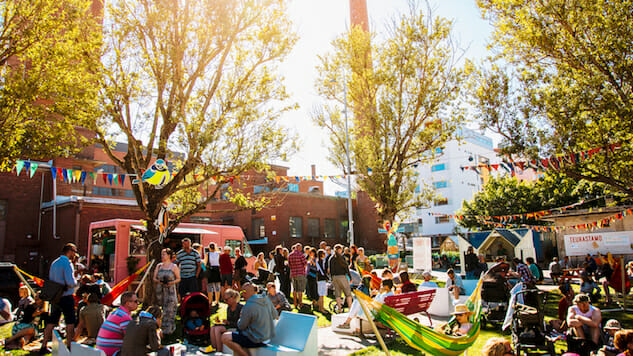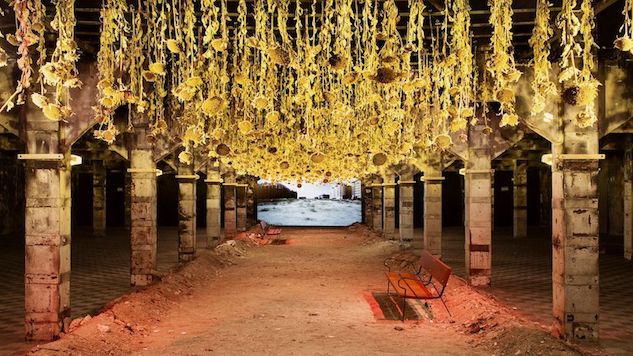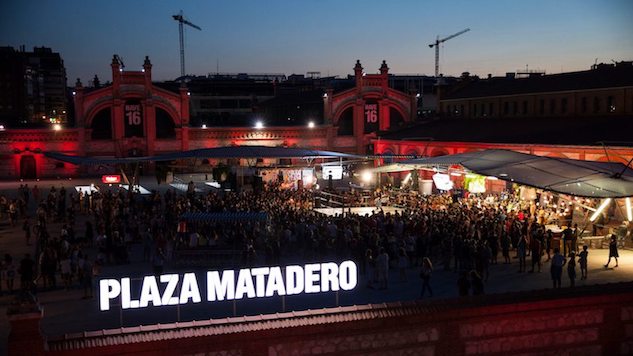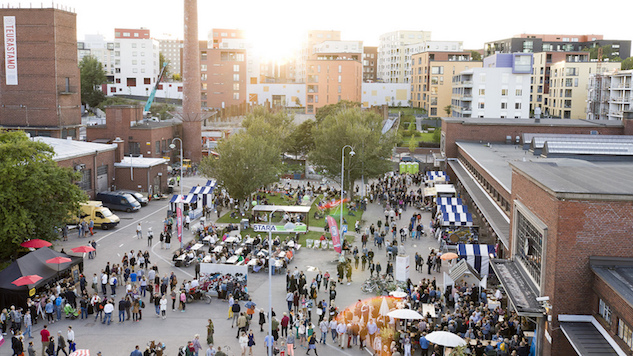
A jet-set lifestyle doesn’t have to be all private planes and decadent digs. In our Jet-Set Bohemian series, we blend the best of high and low for just the right balance … enticing everyone from backpackers to luxury boutique hotel lovers to come along for the ride.
![]()
On a Saturday night when everyone in Madrid just starts thinking about heading out for the evening, I was well into round one of drinks with two friends at the futuristic-inspired NuBel, a new restaurant at the Museo Reina Sofía. As we sipped Rioja wine and picked at tapas like monkfish cheeks soaked in madras curry, my friend Andrea, a Madrid native, asked what my plans were for Sunday.
In Madrid, Sundays are seen as a moveable feast that starts with brunch around 3 p.m. and continues with tapas on the terraces of Plaza de la Cebada (barley square) and Plaza de la Paja (straw square) in La Latina, one of the oldest neighborhoods in the city. The former walled area was home to artisans and manual workers during medieval times when these squares were known more for their farmer’s markets than their euro glasses of Spanish wine and jamón-stuffed croquettes.
Just a few streets away, however, you’ll still find one of the city’s most famous flea markets, the sprawling El Rastro. “I was thinking of checking out the market for a bit,” I said, as Andrea gave me a look saying “that’s the last place you should be on a Sunday.”
“There’s a great design market on the outskirts of the city, and it’s in an old slaughterhouse,” she replied.
 Photo courtesy of Matadero Madrid’s Facebook page
Photo courtesy of Matadero Madrid’s Facebook page
Held the first weekend of each month, the Mercado Central de Diseño takes over the Matadero Madrid, a former slaughterhouse and livestock market. Built between 1908 and 1928, Matadero sits near the River Manzanares, which separates the center of Madrid from the southern part of the city. Following the Spanish Civil War, the slaughterhouse was used as everything from a potato storage warehouse to the headquarters of the national ballet before shutting its doors in 1996. In 2007, the original architecture was restored and the space reopened as Matadero, a contemporary arts center with a cineteca, exhibition spaces, and a radio and recording studio.
During the design market, Spanish artisans set up their stalls of handmade jewelry and custom-designed furniture along the open-air Plaza Matadero between the brick- and stone-covered buildings once housing livestock. Twenty- and thirty-somethings play ping pong in the square while sipping Aperol Spritz, and street food stands sell tacos with freshly made tortillas to lines of people that seem to get longer as the day wears on.
Matadero is just one of a handful of historic slaughterhouses around the world being reimagined and reborn, transforming into cultural hubs and meatpacking districts in cities from Rome to Shanghai.
 Photo courtesy of Matadero Madrid’s Facebook page
Photo courtesy of Matadero Madrid’s Facebook page
In December, Helsinki’s first distillery in over a century debuted a bar component in the same building that operated as a power plant for 30 years. Located in the Abattoir, Teurastamo served as Helsinki’s slaughterhouse for nearly 70 years, from the 1930s to the 1990s. The Helsinki Distilling Company is now one of 10 businesses moving in to the neighborhood that’s billing itself as the city’s “Meatpacking District.”
After sipping on cocktails blended with Helsinki Distilling Company’s Helsinki Dry Gin, crafted from hand-picked botanicals like Arctic lingonberry, we strolled next door to Flavour Studio. The cooking school and event space plays on the neighborhood’s past with courses designed around locally sourced Nordic ingredients showcasing what the city’s cuisine has become in more recent times. Food seems to be the main connecting factor here, as the neighborhood houses everything from garden markets to coffee roasters and restaurant spaces, where you can find cuisine as wide-ranged as Chinese street food and handmade Italian gelato, taken to go and eaten in the Abattoir’s open-air square.
Rome’s Testaccio neighborhood is often called the heart of the city and birthplace of Roman cuisine, with its deep-rooted culinary culture dating back over two thousand years to the Roman Republic. In the 20th century, the neighborhood was home to the city’s main slaughterhouse, Mattatoio, and the working-class neighborhood made use of some of the unwanted quinto quarto, harder-to-sell parts like organs and intestines, which become bases for local dishes.
 Photo courtesy of Visit Helsinki
Photo courtesy of Visit Helsinki
Near the former slaughterhouse, you’ll still find butchers and fishmongers selling their fresh cuts and catches at the Nuovo Mercato di Testaccio neighborhood market, while the industrial-style abattoir itself has been reborn as MACRO Testaccio, the Museum of Contemporary Art of Rome. Specializing in Italian contemporary art from the 1960s on, the museum sits in two of the slaughterhouse’s old buildings, seen as some of the city’s most important for their modernist style that strays from the 19th century’s more classic architecture.
In Shanghai, the municipal council opened 1933 as a cattle slaughterhouse that at one point was the largest in the Far East, producing two-thirds of the city’s meat. When the Chinese People’s Liberation Army took the reigns from the national government in 1949, they brought the slaughterhouse back to the people and transformed it into Shanghai’s main meat production base. Meat processing slowly moved from the city center to the suburbs, and the Jiulong Hotel had a short life here in 1997 before the slaughterhouse shut down entirely in 2002. After a full renovation, 1933 reopened in 2007 as a creative lifestyle experience center. Its five classical British-meets-ancient Roman basilica-style buildings, sculptural cattle path and spiral columns now house jewelry shops and theaters, in addition to serving as a backdrop for A-list events like Porsche’s 60th anniversary and Ferrari F1 fêtes.
Main image: Photo courtesy of Jussi Hellsten
Lane Nieset is Paste’s Jet-Set Bohemian columnist and a freelance writer covering all things travel from her home base in Nice, France.